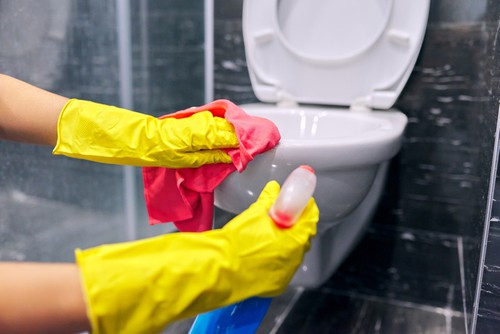How To Clean And Disinfect Toilet Efficiently?

How To Clean And Disinfect Toilet Efficiently? The toilet is the champion among other household surfaces when it comes to accumulating germs. Cleaning it thoroughly a couple of times a week is absolutely necessary to keep you safe from disease.
Here is a guide to help disinfect and clean toilets efficiently.
Table of Contents
1. The bowl

Always start your toilet disinfection with the bowl, as most bacteria reside there. Use a Clorox bottle or any other reliable disinfectant that guarantees to kill 100% of germs. Sanitizers are just too small and weak to deal with the billions of tiny monsters in the toilet bowl.
Spread a generous coat of disinfectant on the entire surface of the bowl, starting from the rim. Then, use a toilet brush to scrub the solution into the bowl and spread it to each cranny and nook. Insistently run the brush underneath the bowl rim.
This hard-to-reach place shouldn’t stay without attention, as many germs use it to set up their camp.
Don’t forget to wear gloves to protect your skin while using the brush. Now that you’ve finished the brushing job, let the disinfectant sit on the bowl surface for 5 minutes. That’s an optimal time to allow the potent chemicals to destroy all colonies of pathogens.
The final step is to flush the solution away.
2. The rest of the commode

The commode’s exterior has a pretty intricate design with crannies and nooks that are sometimes hard to access. Use a disinfectant in a spray bottle to be able to reach hardly accessible areas of the toilet.
Start with the foundation of the commode and steadily make your way up to the lid. Treat underneath the tank and the sides in detail. The disinfectant has to be much, yet avoid applying it in exaggerated amounts.
It may drip down the commode and spread on your floor and even reach the bathroom rug if it’s in the near vicinity. Most disinfectants contain bleach which can discolor the fabric.
Continue with lid, treating it from inside and outside with care. Next, thoroughly address the seat. Don’t forget about the small strip between the seat and the tank. Once you have applied the disinfectant, let the commode stay wet for 10 minutes.
Then use paper towels or a clean sponge to eliminate the moisture and leave the toilet perfectly dry. A dry environment is less likely to grow bacteria.
3. The supplies

After disinfecting the toilet, you are good to pay some attention to the brush too. Leaving it in the holder with water may sooner or later lead to mold growth. That’s why it would be wise of you to periodically treat the brush with disinfectant.
After the treatment, let the brush air dry. If speaking of gloves and sponges, soak them in a bowl with bleach and let them sit for 10 minutes. Then let them air dry. Keep in mind that gloves and sponges you use for toilet cleaning should be only for toilet cleaning.
Avoid using them for sanitizing other household surfaces.
How often to clean and disinfect the toilet?

Disinfecting the toilet has a crucial role in preventing contact with health-threatening germs and minimizing their spreading. You are good to disinfect the toilet once in 3 days in the flu season. This will reduce the risk of contamination if someone in your house is sick.
Outside the flu season, you can disinfect at longer intervals. Once a week or twice a week can pretty much be enough to keep the bacteria expansion in check. However, the number of people living in the house has also a large role in determining how often to clean the toilet.
The more people use the commode, the more germs end up on it. Hence, it becomes a necessity to disinfect it more often.
How To Clean And Disinfect Toilet Efficiently? – Conclusion

You should clean the toilet only with potent disinfectants that destroy the germ populations fully. Use a toilet brush to loosen the tough germs and spread the disinfectant on all surfaces.
For hard-to-reach commode parts, use a spray disinfectant to ensure no hidden bacteria stays alive. Keep in mind that the treated surface has to stay wet for a while to let the disinfectant do its job. Then you can wipe the surfaces dry with paper towels or sponges.




